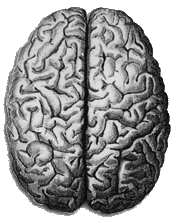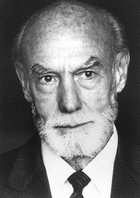A web site full of stuff that should be useful
| AS Psychology |
| Core Studies |
| Links |
| Course Content |
| Exam Questions |
| Psychological Investigation |
| Forum |
| Glossary |
| About this site |
|
|
![]()
The Sperry Page
|
Below is a very brief summary of the Sperry study. You will need to use the more detailed summary here to revise for the exam. You can also find all of the past exam questions on Sperry's study here.
Here is a
multi-choice quiz. |
Roger Sperry This site provides a good review of Sperry's work. www.nobel.se/medicine/articles/sperry/ This link to neuroscience for kids has some good stuff on split brain experiments. In fact, if you have time the whole site is worth exploring. |
|
The participants were 11 ‘split-brain’
patients, that is, they were patients who had undergone disconnection of the
cerebral hemispheres. The participants had all undergone hemisphere
deconnection because they had a history of advanced epilepsy which could not
be controlled by medication. Sperry used a number of ingenious tasks in order to investigate lateralisation of brain function. One of the tasks used to send information to just one hemisphere involved asking participants to respond to visual information. This involved blindfolding one of the participant’s eyes and then asking them to fixate with the seeing eye on a point in the middle of a screen. The researchers would then project a stimulus on either the left or right hand side of the fixation point for less than 1/10 of a second. The presentation time is so small to ensure that the participant does not have time for eye movement as this would ‘spread’ the information across both sides of the visual field and therefore across both sides of the brain. As language is processed in the left hemisphere, when a stimulus is presented to the left visual field of a split-brain patient they should not be able to name the stimulus. Below is a summary of some of the main results When participants were presented with an image in one half of their visual field and then presented with the same image in the other half of the visual field they responded as if they had never seen the image before. If the same image was presented in the original visual field the participants were able to recognise the image as one they had seen before. Participants were not able to give a description of an image that was presented to the left hand side of the visual field. The image was either not noticed or just appeared as a flash. Although they could respond non-verbally by pointing with their left hand to a matching picture or selecting an object presented among a collection of other pictures and objects. This of course only works with right-handed participants. If two symbols were presented simultaneously, one on either side of the visual field (e.g. a dollar sign on the left and a question mark on the right) and the participant was required to draw with their left-hand (shielded from their own view) what they had seen, they would draw the left visual field symbol (a dollar sign). If they were required to say what they had just drawn, the participant would say by name, the right visual field symbol (a question mark). Objects put in the participants hand for identification by touch could be described or named in speech or writing if they were in the right hand but if placed in the left hand, the participant could either only make wild guesses or even appeared to be unaware that anything at all was present. However, if the object was taken from the left hand and placed in a ‘grab bag’, or was scrambled among other test items, the participant was able to search out and retrieve it with their left hand. An interesting example of lateralisation of function is when two different objects were placed in each hand at the same time and then removed and hidden for retrieval in a scrambled pile of test items. Each hand hunted through the pile and searched out its own object. During the search each hand was seen to explore, identify and reject the item for which the other hand was searching. Although the performance of ‘normal’ participants would be slowed down by the competing demands of the tasks, the people with hemisphere deconnection could actually perform these double tasks in parallel, as quickly as they could perform one of the tasks on its own. It is worth noting though that even though Sperry showed that split-brain patients were better at completing such highly unusual tasks that this would have no advantage in the real world. Sperry argued that his studies give
considerable support to his argument of lateralisation of function. That is,
that different areas of the brain specialise on different tasks, such as the
left hand side being responsible for language. He also went on to argue that each
hemisphere has its own perceptions and memories and experiences. |
|

